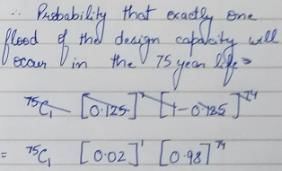Test: Floods - 2 - Civil Engineering (CE) MCQ
10 Questions MCQ Test - Test: Floods - 2
Kirpich equation is used to determine which one, of the following?
The confidence interval for the estimate of a value XT by Gumbel’s method depends on
A bridge has an expected life of 50 years and is designed for a flood magnitude of return period 100 years. What is the risk associated with this hydrologic design?
The use of the unit hydrograph for estimating floods is limited to catchments of size less than
Probability of a 10 year flood to occur at least once in the next 4 years is
The use of rational formula for estimating floods is limited to catchments of size less than
A hydraulic structure has been designed for a 50 year flood. The probability that exactly one flood of the design capacity will occur in the 75 year life of the structure is
























